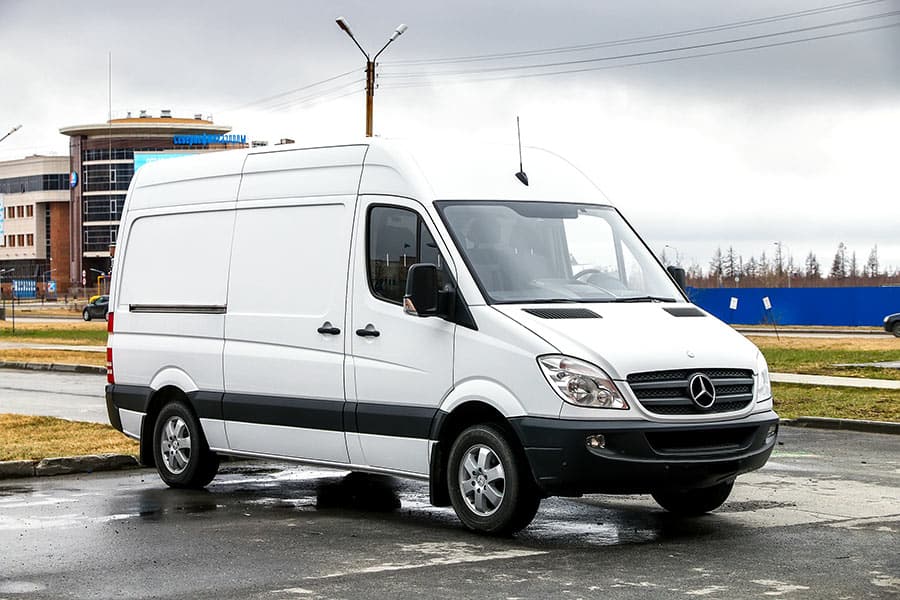
One thing to consider when buying any vehicle is the resale value you can expect down the road. After all, it would be disappointing to try and trade up to a newer vehicle only to discover that yours has little to no resale value. There are a lot of excellent reasons to buy a Mercedes-Benz Sprinter van, but a discerning buyer will wonder: do Sprinter vans hold their value?
Mercedes-Benz Sprinter vans hold their value very well compared to the competition. My research found that the Sprinter held more than $6,500 in additional value compared to competing vans. If you are looking for a van with good resale value, you can’t do better than the Sprinter van.
Why might this be? What affects resale value? Is it reputation, reliability, initial cost? As we will see, many factors affect the resale value of a van. Read on to learn more.
Good Vans Hold Good Value
Sprinter vans have a reputation as solid, reliable vehicles suitable for a wide variety of tasks. Drivers use the Sprinter for everything from delivering parcels to hauling tools and equipment. The Sprinter is also the chassis of choice for a lot of Class B RVs. The popularity, reliability, and utility of these vehicles help them hold their value as they age.
How is the value of a vehicle determined? What kind of factors affect how a vehicle holds value? The two primary factors determining a vehicle’s long-term value are mileage and condition. Other factors include options, add-ons, and personalizations. Location can also affect value: vans exposed to five years of road salt in a snowy place may be less valuable than vans stowed away from corrosive conditions.
Mileage is an easy to understand, objective factor affecting value. Higher mileage equals lower value. This determinant makes intuitive sense if we think of it from the buyer’s standpoint. Almost everybody would prefer a vehicle with 30,000 miles on it over one with 230,000 miles on it.
While it is true that some vehicles are reliable into very high mileages, the simple fact is that mileage is generally used as a proxy for overall mechanical wear. A heavily used van is much more likely to have worn parts that will soon need replacement.
Condition is a more subjective term, and it’s harder to predict. The best way to describe how buyers assess condition is to think of it as aesthetic wear-and-tear.
The vehicle might have a beautifully maintained engine and low miles, but if the seats and upholstery are stained, torn, and smelly, the vehicle’s resale value will be adversely affected. Exterior condition is also important: buyers do not like dings, scratches, nicks, and rust. Even sun-faded paint can affect the value of your vehicle.
Options, add-ons, and personalization will also affect your resale value. Some options, like leather seats, tinted windows, and premium factory sound systems, can add value to a vehicle.
Other options rarely add value but always remove value if they don’t work or aren’t installed correctly. These are options like air conditioning and power windows: nobody wants to buy a car with a busted A/C system, and if your A/C is broken, it will hurt your resale value.
Finally, customizations. Customizations rarely add value in traditional vehicles, although this may be different in the RV market. In terms of traditional vehicles, however, customizations rarely add value. Few people want your specific custom paint job, personalized steering wheel cover, or wheel spinners – not that you’d find these on the average Sprinter, but the point remains.
What can you expect to spend for a new Sprinter van?
Van Type – Starting Price
- Cargo – $36,355
- Crew – $41,375
- Passenger – $43,120
- Cab Chassis – $40,595
Related Posts
- What’s The Difference Between A Sprinter 2500 And 3500?
- How High Is A Mercedes-Benz Sprinter Van? A Complete Guide
- Why Do Sprinter Vans Rust – And What You Can Do
- How Long Do Sprinter Vans Last?

How much better does the Sprinter hold value than the competition? To test this, we entered four vehicles into the Kelley Blue Book car value calculator: the Ford Transit, the Nissan NV, the Ram ProMaster, and the Mercedes-Benz Sprinter.
All vehicles were entered as a 2016 extended-body cargo van with white paint, standard options, and 80,000 miles on them. We also assumed that the van was in “Good” condition, which Kelley Blue Book defines as “some repairable cosmetic defects and free of major mechanical problems.”
The results:
Van – Trade-in Value
- Ford Transit 350 Cargo – $23,555
- Nissan NV 3500 – $17,081
- Ram ProMaster 3500 Cargo – $23,801
- Mercedes-Benz Sprinter 3500 Cargo – $30,004
Clearly, the Mercedes-Benz Sprinter has held the highest resale value. Even the closest competing van is worth about $6,500 less. The retention of value is a testament to the popularity and overall quality of the Sprinter. You can also get around $500 to $600 more for a private party sale, if you want to sell it yourself.
Does the specific model of your Sprinter affect the resale value? Yes. Generally, a less expensive new vehicle will have less resale value than a more expensive new vehicle. Let’s compare the 2019 Sprinter 1500, 2500, and 3500 models. We’ll assume white paint, 30,000 miles, and standard equipment:
Sprinter Model – Resale Value
- 1500 Cargo – $33,662
- 2500 Cargo – $38,161
- 3500 Cargo – $38,649
The differences in value between the 1500, 2500, and 3500 are comparable to price differences when the vans are new. Generally, a higher initial cost will lead to a higher resale value. This fact is good news for people considering buying a new Sprinter van: if you take care of it, odds are it will hold value well over the years.
Check out these five items to help you have a better camping experience:
- Biodegradable Liquid Soap
- Microfiber Towels
- 300W Power Inverter
- Battery Operated Fan
- Square Pie Iron
What is the Optimal Time to Trade in my Sprinter Van?
Every van’s story is unique. However, mileage is the most commonly used metric to evaluate the worthiness of a vehicle. This indicator is used because mileage is closely tied with mechanical wear-and-tear, making it a good proxy for value.
Increasing mileage also means increasing maintenance. As vehicles hit specific benchmarks, major mechanical work often needs to be done:
- Timing belts need to be replaced.
- Tires and brakes wear out.
- Batteries lose their capacity.
The need for this kind of work causes the resale value to drop off sharply after about 80,000 miles.
Depending on your specific use cases, you may be able to negotiate higher or lower trade values. Still, a good rule to remember is that your van’s resale value is inversely proportional to mileage: more miles on the odometer reduces the value to the buyer.
Is the Resale Value Better on a 4×4 Than a 4×2?
Two of the key differences between a 4×4 and a 4×2 in terms of resale value are complexity and initial cost. A 4×4 vehicle has more mechanical parts than a 4×2. It also tends to have a higher initial cost. This fact can cut two ways: a 4×4 in good mechanical condition can hold value, but mechanical issues will sink the value of your van.
Another consideration: buyers may not need or want a 4×4 vehicle, depending on their needs. A van destined for a life in suburbia or the city is not likely to need 4×4 capability as much as a van destined for towing or driving on unimproved or muddy roads. Your location may affect this as well: residents of snowy Michigan might get more value from a 4×4 than those living in sunny Florida.
How Do I Get the Best Resale Price?
There are three crucial factors to remember when trying to get the best resale value for your vehicle:
- Maintenance
- Mileage
- Cleanliness
The most critical thing to keep good resale value is to take care of your vehicle. Make sure you follow the appropriate service intervals and guidelines for your van. Don’t skip oil changes, routine checks, fuel system flushes, tire rotations, and other tedious but essential maintenance tasks.
Keep a vehicle maintenance log, this one works well, and it also has a list of standard service items, plus it has additional space for other services that you might have completed.
Mileage is the next factor. As we’ve discussed, high mileage means low resale value. If you intend to resell your vehicle, do what you can to keep the odometer under that magical 80,000-mile marker. Finally, cleanliness. When someone comes to buy a car, they want it to be clean.
Cleanliness applies to the inside and the outside. A van covered in mud, dirt, dust, road debris, and other crud will not be as attractive to a buyer as a gleaming, freshly-washed van. Buy a vehicle wash kit and give your van a thorough hand washing to make it as attractive to buyers as you can.
The interior must also be clean: vacuum the floors and get some Armor-All Wipes or another product to clean off the interior surfaces. Additional items to consider when getting your van ready for trade-in or prospective buyers are:
- Change the cabin air filter.
- Get rid of the trash.
- Do your best to eliminate any offensive odors in the cab so your van smells nice.
Sprinting To The Bank
The Mercedes-Benz Sprinter is one of the premium commercial vehicles on the market today; this applies to the resale market too. The Sprinter holds a good resale value at baseline. Doing everything you can to keep your Sprinter clean, well-maintained, and in good operating condition will attract buyers to your vehicle when it comes time to sell it. If you take good care of your Sprinter, you’ll be sprinting to the bank with a nice, plump check after resale.





